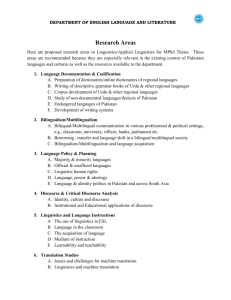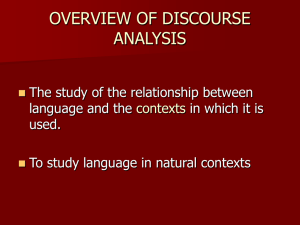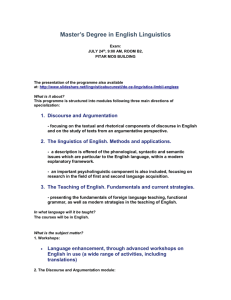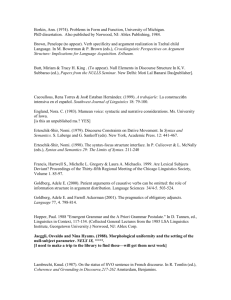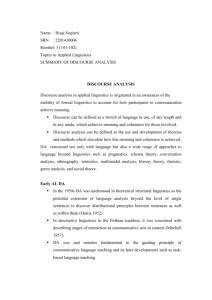Business Discourse across 'cultures': data selection, collection and
advertisement
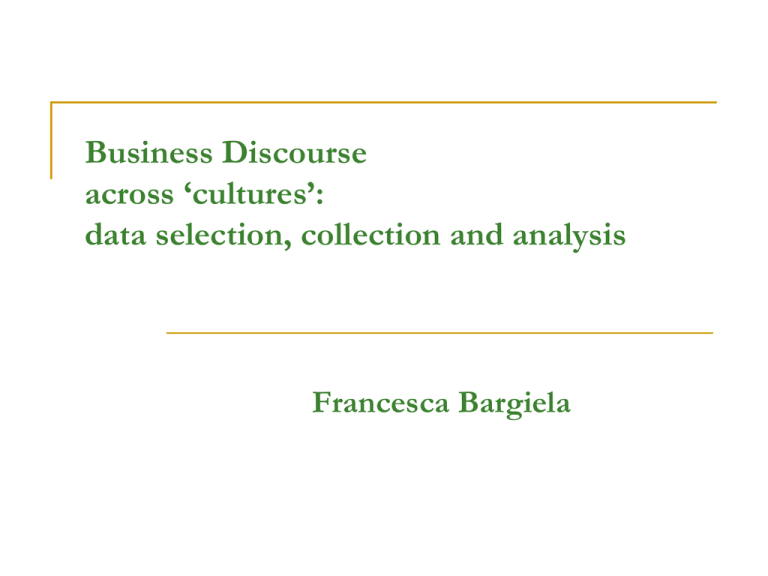
Business Discourse across ‘cultures’: data selection, collection and analysis Francesca Bargiela (What I said in the) Abstract personal chronology of business discourse research changes in methodological approaches that have characterised the evolution of business discourse research. issues of data selection, collection and analysis (in research across ‘cultures’) Centre for Applied Linguistics April 29th, 2010 2 Applied linguistics, LSP, ESP, and …………………… Applied linguistics Language(s) for Specific Purposes English for Specific Purposes Centre for Applied Linguistics April 29th, 2010 3 ……. Business Discourse A definition… ‘the interaction which takes place between individuals whose main activities are located within business and whose contact is motivated by matters relating to their respective businesses’ (Bargiela-Chiappini and Nickerson 1999: 2). Centre for Applied Linguistics April 29th, 2010 4 The relationship between reality and teaching materials Marian Williams (1988) EFL: The gap between ‘theory’ and practice Centre for Applied Linguistics April 29th, 2010 5 The analysis of Business Discourse is….. …….contextual and intertextual, self-reflexive and self-critical, although not necessarily political, and is founded on the twin notions of discourse as situated action and language as work. Linguistics ‘applied’? Centre for Applied Linguistics April 29th, 2010 6 Business Discourse: a personal chronology 1. 2. 3. ‘Prehistory’ : 1970s-80s History: 1990s Recent developments: 2000s Centre for Applied Linguistics April 29th, 2010 7 Business Discourse: a personal chronology 1. ‘Prehistory’ (Before my time….) The Seventies: language audits, language needs analysis (text analysis) (LSP) The Eighties: negotiation studies (quantitative methods/simulated data); business correspondence and documentation (genre analysis) Lampi (1986) real-life negotiations + linguistic analysis; Europe: LSP/ESP → text analysis (grammar, vocabulary, text structure) US: business communication → ‘how-to’ approaches Centre for Applied Linguistics April 29th, 2010 8 The Seventies: language needs analysis; genre analysis (LSP/ESP) GENRE ANALYSIS: John Swales and his generic model of the ‘research article’ - MOVES & STEPS Move 1: Establishing a Territory Step 1: Claiming Centrality and/or Step 2: Making Topic Generalisations and/or Step 3: Reviewing Items of Previous Research Move 2: Establishing a Niche Step 1A: Counter-claiming or Step 1B: Indicating a Gap or Step 1C: Question Raising or Step 1D: Continuing a Tradition Move 3: Occupying the Niche Step 1A: Outlining Purposes or Step 1B: Announcing Present Research Step 2: Announcing Principal Findings Step 3: Indicating Research Article Structure (from: GENRE A NA LYS I S : A KEY TO A THEORY OF ESP? By T Dudley-Evans – 2000) Centre for Applied Linguistics April 29th, 2010 9 The Eighties… FIELDS/APP-ROACHES METHODS/DATA TYPE 1. quantitative methods (simulated data) 2. qualitative methods: genre analysis, text analysis, contents analysis (business correspondence/business documentation) 1. negotiation studies → 2. genre studies → Lampi (1986) My experience ….. (needs analysis, ISP, simulated negotiations….) → First linguistic analysis of business negotiations DATA (access, selection, analysis) + METHODS (survey, genre analysis, speech acts analysis ) Centre for Applied Linguistics April 29th, 2010 10 Lampi (1986) Linguistic components of strategy in business negotiations. Centre for Applied Linguistics April 29th, 2010 11 Business Discourse: a personal chronology 2. History Nineties: Boden (1994) meetings + CA; Bargiela and Harris (1997) meetings +pragmatics and DA + comparative analysis 3 important developments: from written to spoken language ethnographic approaches to BD multi-disciplinarity Centre for Applied Linguistics April 29th, 2010 12 The Nineties….. FIELDS/APPROACHES 1. METHODS/DATA TYPE business discourse (+inter and cross-cultural+multi-method) → 2. genre studies /discursive approaches (+multimodal)→ 3. politeness studies 1. 2&3 qualitative methods: genre analysis/ multimodal analysis/emails, websites, new corporate documents→ CSR) CA + social theory (meetings) Boden (1994) qualitative methods: pragmatics, social psychology, DA, CA, CDA/ reallife negotiations, meetings, presentations etc. My experience…. written correspondence and authentic negotiations (BC projects) ; organisational ethnography; meeting analysis → DATA (access, selection, analysis) METHODS (speech act analysis, pragmatics, ethnography, interviews, observation, sense-making) (Organisation studies + management studies) Centre for Applied Linguistics April 29th, 2010 13 Boden (1994) The business of talk. Centre for Applied Linguistics April 29th, 2010 14 Business Discourse: a personal chronology 3. Recent developments Multidisciplinarity → + dialogue with the US Multi-method research Business Discourse goes East (ELAB) Intercultural communication and the ‘cultural other’: Centre for Applied Linguistics April 29th, 2010 15 The 2000s: Business Discourse → Asian Business Discourse(s) (1) Cross-field dialogue → US (management communication, organisational communication, business communication, rhetorical analysis …. → UK+Australia (organisational discourse) Interculturality → collaboration with Asian countries (China, Japan, Malaysia, Thailand….= ELAB network) Centre for Applied Linguistics April 29th, 2010 16 Future developments: Business Discourse as a metaphor for dialogue Multi-disciplinary…. socio-pragmatics, intercultural pragmatics, critical anthropology, critical cultural studies, cultural sociology, cultural psychology, hermeneutics, …. Multi-method… DA, CA, ethnomethodology, rhetorical analysis, ethnography, multi-modal analysis, visual analysis… Centre for Applied Linguistics April 29th, 2010 17 Business Discourse research: some trends From written to spoken data From quantitative to qualitative approaches From mono-method to multi-method From intra-cultural to cross- and inter-cultural From Euro- (and US-) centred to ‘international’ From mono- to multi-disciplinary Centre for Applied Linguistics April 29th, 2010 18

